If there were ever a contest to determine the toughest motorcycle built, this military-spec Zundapp would definitely be in the running.
It was designed to run across the broiling Sahara desert, the frozen expanses of wintertime Russia, the rocky mountains of the Balkans. It had a grunty 750cc flat-twin engine powering both the rear and the sidecar wheel, with a limited-slip differential that could be locked into tandem drive when the going got seriously tough.
As the German armed forces, the Wehrmacht, geared up for World War II, it wanted mobility, and was hooked on having lots of motorcycles with sidecars; such an outfit was considered by military standards to be rather light, coming in at half a ton, with a couple of extra cans of gas and a canister or two of ammunition strapped on wherever it was suitable. With one soldier driving (the appropriate sidecar terminology), another in the sidecar manning a machine gun and a third hanging on to the pillion grab bar for dear life, the Nazi propaganda films loved showing swarms of these rigs bounding over open country. Those driven sidecar wheels were a requirement in order to enhance traction, and if the outfit did get good and proper stuck, it was light enough to be pushed free.
This was 20 years after the company had begun making motorcycles. The Zunder-Apparatebau (detonation-apparatus) company had been making bomb fuses and other explosive materials in World War I, but following Germany’s defeat, the owners thought it would be wise to pursue some less bellicose manufacturing lines, as well as disguise the company name a little by abbreviating it. They decided to start building small motorcycles, and the first Z22, a 211cc single with belt drive, came off the assembly line in 1921. By the fall of 1929 more than 28,000 Zundapps of 250cc or less had been sold. And then came the Depression.
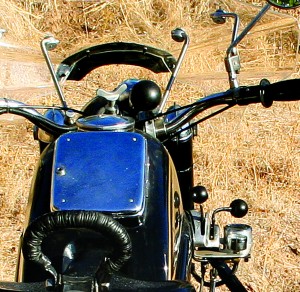
The decision was made to stick with motorcycles, and an engineer by the name of Richard Kuchen was hired to develop a whole new line. The K (K for Karden, or driveshaft) series began in 1933, with K400 and K500 sidevalve flat twins, followed by the K600 and K800 sidevalve flat fours. The transmissions were the most unusual, as Kuchen decided to use chains instead of gears. In 1935 the factory made the KS500 (Karden Sport), with an OHV boxer engine, and the larger KS600 in 1938.
Then the war-mongers got into the act, demanding that Zundapp produce a 750cc three-wheeler for military use—and the uniforms wanted some interchangeability with similar BMW machines that were also being developed. This meant having a BMW-type transmission, which required Zundapp to go back to using gears in the gearbox.
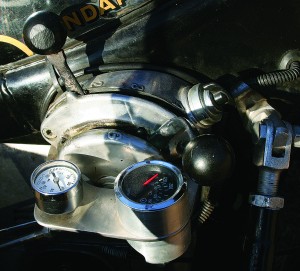
It was a workaday engine, with a 75mm stroke, 86mm bore. Carburetion was performed by an automotive-type Solex. In anticipation of extremely cold weather, a little tube ran off the left-side header pipe that would warm the air going into the carb; this warming device could be disconnected with the click of a switch. Intake air went through three “tornado” cleaners that would spin the air as it came in, forcing all the particles of dirt to separate and get trapped.
The transmission had an extra right-angle gear, so the kickstarter movement was parallel to the bike, rather than the awkward outward movement found on BMWs. This was much easier for the rider to operate—especially when getting strafed by a P-51 Mustang. Up on the right side of the tank was the four-speed handshifter, along with another lever to reverse the mechanism, giving four backward speeds—useful if the rider got caught with a rolling barrage coming toward him.
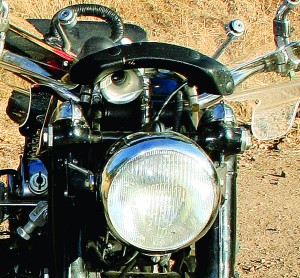
The driveshaft was open, running down the right side, and since there was no rear suspension, the shaft connection was quite basic. Beneath the rider’s right butt cheek was another lever, used for shifting the differential from limited slip to full lock. Trying to steer the KS750 around a corner with a locked diff is not fun, but it is very handy when struggling to get out of mud or sand.
The hardtail frame was of pressed steel, cradling the engine and wrapping around the 23-liter gas tank, which gave it a range of more than 200 miles; a toolbox was built into the middle of the tank. Springs under the Drilastic seats kept the rider and pillion reasonably comfortable. The front fork was a girder type, using a parallelogram of four links, running from the steering head to the springs concealed in the tops of the girders. This fork offered limited travel, but was no wimpy deal, being seriously strong and not about to bend when coming upon an unexpected ditch. The front axle had extensions on each side about 5 inches in length, placed there to allow a soldier to stand on and put weight on the front wheel, enabling the rider to steer better when the going was very rough indeed. The sidecar chassis used leaf springs to try to provide a minimum of comfort to the passenger, and the car itself here is a Steib, though other manufacturers provided them as well.
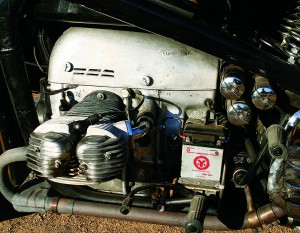
Wheels were 16-inch, and were all interchangeable, so the spare on the back of the sidecar could go on any wheel. Tires were of a sizable 5.00-inches, all the better for crossing soft terrain. A hinged rear fender allowed that wheel to be pulled easily. Tire rotation was recommended, to keep the wear on all four skins equal.
An interesting historical parallel lies in the fact that just as the Wehrmacht was deciding on the requirements for what would become the KS750, the American army was laying out the specs for a small general purpose (GP, by military designation) vehicle that became known, acronymically speaking, as the “jeep.” That had the advantage of four-wheel drive, two-wheel steering, seating for four soldiers, and was a lot more useful than any sidecar combination could be. By the time the first KS750, with a Steib sidecar, rolled out of the factory in Nurnberg, Germany, in 1941, it was militarily out of date. Zundapp built some 18,000 of these rigs before getting bombed out of business in late 1944.
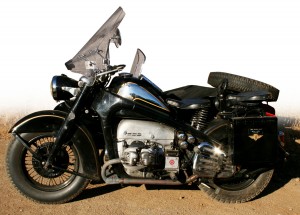
Many of these KS750 models ended up in Eastern Europe after the war, being used as basic transportation until the Berlin Wall came down in 1989. At which point savvy Western collectors rushed into the East offering used VWs for these aged machines, which the owners were only too glad to accept. And many, like this one, got a new paint job.







